Measuring flash durations of speedlight and studio lighting and strobes
It has been some time since I last delved into a technical article, but today we're delving into the world of flash durations. Despite extensive searching, I couldn't find any comprehensive resources offering real-world measurements of flash durations for speedlights, especially t.1 measurements.
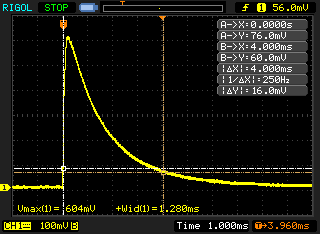
Lights Tested
In this endeavor, I set out to measure the flash durations of various lights, including:
- Canon 580EX
- Nikon SB-24
- Nikon SB-26
- Nikon SB-28
- Nikon SB-80DX
- Yongnuo YN560
- Cactus KF36 (Vivtar 285HV)
These speedlights employ IGBT triggered power control, resulting in shorter durations for lower power discharges. Additionally, I conducted tests on the following units:
- Broncolor Flashman floor pack with Pulso 2 head (1800Ws symmetric)
- Broncolor Impact 41 monolight
- Godox 120 Ws
- Alien Bee B400 160 Ws
- Paul C Buff Einstein E640 (640 Ws), measured for constant color mode and action mode
- A "Mystery" eBay light (400 Ws)
In the subsequent sections, I will present the results of these real-world measurements. Towards the end of the article, I will provide details on how these measurements were conducted.
Measurement Technique
For the measurement process, I constructed a basic circuit using a BPV11 phototransistor as the sensor. The output from this sensor was then read by an oscilloscope, and the t.1 interval was determined by setting two cursors to correspond to the respective t.1 amplitudes.
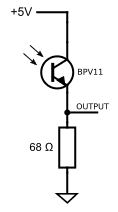
The selection of the resistor was made to ensure that the phototransistor consistently operated within its linear region, with collector current well within the maximum limits. The device never reached saturation. It possesses a response time between 5 to 6 microseconds for both turn-on and turn-off, which proved to be sufficiently fast for our measurements, staying within 5% accuracy for the swiftest measurements.
The t.1 (sometimes referred to as t0.1) was measured as depicted below:

Results
Flash Duration in Microseconds at Different Power Settings
| Light | 1/1 | 1/2 | 1/4 | 1/8 | 1/16 | 1/32 | 1/64 | 1/128 | 1/256 |
|---|---|---|---|---|---|---|---|---|---|
| Canon 580EX | 4000.0 | 1088.0 | 484.0 | 266.0 | 166.0 | 105.6 | 71.6 | 50.4 | |
| Nikon SB-24 | 4322.0 | 1260.0 | 732.0 | 292.0 | 192.0 | ||||
| Nikon SB-26 | 4088.0 | 720.0 | 368.0 | 204.0 | 128.0 | 92.0 | 72.0 | ||
| Nikon SB-28 | 3780.0 | 1048.0 | 496.0 | 276.0 | 158.4 | 100.8 | 72.0 | ||
| Nikon SB-80DX | 3888.0 | 864.0 | 408.0 | 222.6 | 135.2 | 90.4 | 63.2 | 45.6 | |
| Youngnuo YN560 | 3200.0 | 736.0 | 356.0 | 202.0 | 124.0 | 79.2 | 54.8 | 43.4 | |
| Cactus KF36 / Vivatar 285HV | 3640.0 | 1504.0 | 636.0 | 188.8 | |||||
| Broncolor Flashman with Pulso 2 head (1600 Ws) | 5680.0 | 5888.0 | 7222.0 | ||||||
| Broncolor Impact 41 Monolight | 4280.0 | 2500.0 | 1408.0 | ||||||
| Godox 120 Ws | 2880.0 | 3480.0 | 3360.0 | 3520.0 | |||||
| Alien Bee B400 (160 Ws) | 824.0 | 928.0 | 1032.0 | 1328.0 | 1120.0 | 1296.0 | |||
| Paul C Buff Einstein E640 (640 Ws), constant color mode | 2560.0 | 984.0 | 592.0 | 472.0 | 396.0 | 336.0 | 296.0 | 268.0 | 236.0 |
| Paul C Buff Einstein E640 (640 Ws), action mode | 2640.0 | 624.0 | 296.0 | 162.0 | 131.2 | 116.8 | 132.8 | 128.8 | 137.6 |
| “Mystery” eBay light (400 Ws) | 7120.0 | 7920.0 | 8000.0 | 8080.0 | 9440.0 | 10160.0 |
Flash Duration in 1/s at Different Power Settings
| Light | 1/1 | 1/2 | 1/4 | 1/8 | 1/16 | 1/32 | 1/64 | 1/128 | 1/256 |
|---|---|---|---|---|---|---|---|---|---|
| Canon 580EX | 250 | 919 | 2066 | 3759 | 6024 | 9470 | 13966 | 19841 | |
| Nikon SB-24 | 231 | 794 | 1366 | 3425 | 5208 | ||||
| Nikon SB-26 | 245 | 1389 | 2717 | 4902 | 7813 | 10870 | 13889 | ||
| Nikon SB-28 | 265 | 954 | 2016 | 3623 | 6313 | 9921 | 13889 | ||
| Nikon SB-80DX | 257 | 1157 | 2451 | 4492 | 7396 | 11062 | 15823 | 21930 | |
| Youngnuo YN560 | 313 | 1359 | 2809 | 4950 | 8065 | 12626 | 18248 | 23041 | |
| Cactus KF36 / Vivatar 285HV | 275 | 665 | 1572 | 5297 | |||||
| Broncolor Flashman with Pulso 2 head (1600 Ws) | 176 | 170 | 138 | ||||||
| Broncolor Impact 41 Monolight | 234 | 400 | 710 | ||||||
| Godox 120 Ws | 347 | 287 | 298 | 284 | |||||
| Alien Bee B400 (160 Ws) | 1214 | 1078 | 969 | 753 | 893 | 772 | |||
| Paul C Buff Einstein E640 (640 Ws), constant color mode | 391 | 1016 | 1689 | 2119 | 2525 | 2976 | 3378 | 3731 | 4237 |
| Paul C Buff Einstein E640 (640 Ws), action mode | 379 | 1603 | 3378 | 6173 | 7622 | 8562 | 7530 | 7764 | 7267 |
| “Mystery” eBay light (400 Ws) | 140 | 126 | 125 | 124 | 106 | 98 |
Download Data
Sample Discharge Curves
Although I didn't save waveforms for every test, I did retain a couple for reference. Here are some examples to provide an understanding of the light output shape of the Canon 580EX at various power levels.
The vertical axis indicates linear irradiance at the sensor, with a doubling in height signifying twice the brightness (one stop). Please note that these plots are not to scale relative to each other.

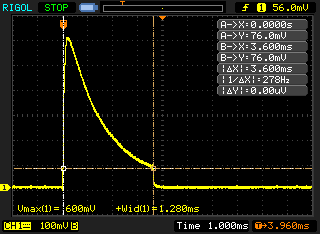
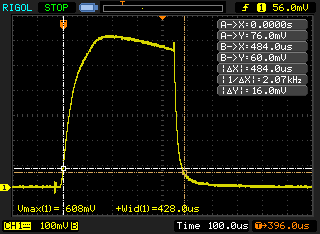
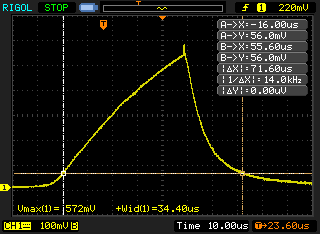
Conclusion
This article may undergo updates as I continue to acquire additional gear for testing and expand the results list.